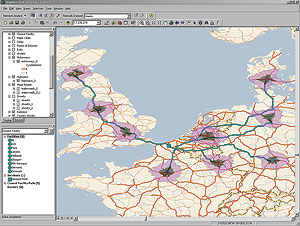 |
The version 9 platform of ArcGIS offers many benefits to the ArcGIS user. This article outlines several top benefits that users can expect from a migration. The fundamental architecture of ArcGIS 9 enables users to deploy GIS functionality and business logic wherever it is needed in desktops, in servers, over the Web, in the field, or in custom clients.
| |

Use ArcGIS Network Analyst to define a service area in a network dataset. |
The ArcGIS 9.0 Desktop release introduced several new key features. The most important of which is a completely new environment for geographic data processing and analysis using the geoprocessing framework. Geoprocessing allows users to work with their processes in a variety of ways, including traditional dialogs, sophisticated scripting, and command-line and interactive visual models using ModelBuilder, an interactive and visual application for creating and executing process models. Other highlights of ArcGIS 9.0 include advanced annotation and labeling tools, improved data interoperability, and global and 3D visualization with the introduction of ArcGlobe as part of ArcGIS 3D Analyst.
ArcGIS 9.1 makes hundreds of quality and performance enhancements to the 9.0 platform. Here are 10 compelling reasons to make the move to the ArcGIS 9.1 platform:
- Increased productivity with improved quality, performance, and usability—ArcGIS 9.1 fixes many issues and adds productivity tools such as pan to selection, pause drawing, better support for longer field names, and a Swipe tool.
- Additional batch geoprocessing tasks and geoprocessing functions previously available only to ArcInfo users—Geoprocessing at 9.1 adds several tools, including a much requested merge tool for combining multiple datasets. In addition, the geoprocessing tools available to ArcEditor and ArcView users have been expanded to provide a robust set of tools for basic geoprocessing. Users can now take advantage of more than 80 additional tools in ArcEditor and more than 60 additional tools in ArcView.
- Ability to create, manage, and analyze transportation networks—The new ArcGIS Network Analyst extension takes advantage of the full capabilities of the ArcGIS 9.1 platform. You can create network datasets and perform analysis on geodatabase data, shapefiles, and Smart Data Compression (SDC) format data. Analysis can be done through easy-to-use, integrated dialogs in ArcMap or via the robust power of geoprocessing or complete control programming against the underlying ArcObjects. ArcGIS Network Analyst is available as an optional extension.
- Nationwide basemap, geocoding, and basic routing—At ArcGIS 9.1, StreetMap for ArcGIS is included at no extra charge with ArcGIS Desktop (ArcView, ArcEditor, and ArcInfo), ArcGIS Engine, and ArcGIS Server. StreetMap for ArcGIS includes the StreetMap USA data set (U.S. only).
- Better making and printing of maps—At ArcGIS 9.1, ArcInfo includes the advanced label placement abilities of Maplex for ArcGIS at no extra charge. Also at ArcGIS 9.1,
ArcPress for ArcGIS is included with all ArcGIS Desktop products at no extra charge. ArcPress for ArcGIS includes a rich set of tools to optimize printing of maps by improving the printer performance and the print quality.
- ArcScan raster data to vector features conversion now included—At ArcGIS 9.1, ArcEditor and ArcInfo include the ArcScan extension at no extra charge. ArcScan allows users to build high-quality basemaps based on existing scanned maps, with automatic and manual tools for converting the scanned maps to features and using advanced algorithms to bridge gaps and follow features.
- ArcGlobe visualization now possible in ArcReader; ArcGIS Publisher used to publish ArcGlobe documents—The ArcGIS Publisher extension supports the creation of ArcGlobe documents (.3dd files) as PMF files that can be viewed with ArcReader. ArcReader has been updated to provide a set of 3D viewing and navigation tools, as well, to work with these published globe documents.
- Projects can be migrated from ArcGIS 8.3 or 9.0 without interruption—Starting at ArcGIS 9.1, you can save a copy of your documents (.mxd, .sxd, .lyr) to a version compatible with ArcGIS 8.3. This allows all users in your organization to benefit more easily from the offerings of ArcGIS 9.1.
- Continue to work with an open, interoperable platform—ArcGIS 9.1 offers broader support of Open Geospatial Consortium map standards, including Web Map Services, Web Feature Services, and Catalog Services.
- Take advantage of the latest software development from Esri—Esri continues to work on providing advanced functionality and bettering the user experience with its software. ArcGIS 9.1 contains many updates driven directly by what the users have requested. These range from minor user interface enhancements to major system fixes to improve the stability and performance of the system.
All ArcGIS Desktop users who are current on their maintenance will automatically receive ArcGIS 9.1. Users in the United States who are not current on maintenance should contact Esri at 1-800-447-9778. Outside the United States, contact your local Esri distributor. For more information about ArcGIS, visit www.esri.com/arcgis.
|